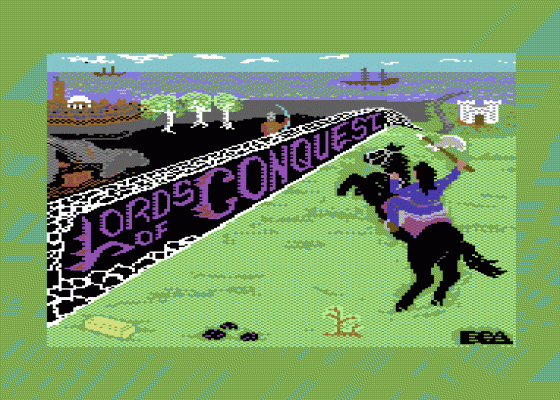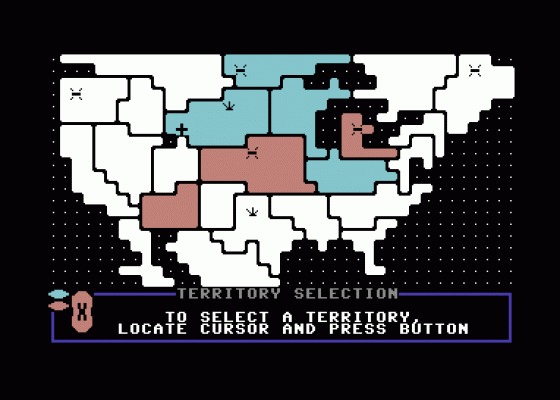
Zzap
 1st December 1987
1st December 1987
Lords Of Conquest
On its back cover, Lords Of Conquest describes itself as a 'great strategy game'. I'd agree with that. However, I'd hesitate to agree with its other claim: 'better than any board game'.
It is not a wargame. Although it concerns itself with conquest, it is of the most abstract kind. Lords Of Conquest is an attractive attempt at a computer version of the type of glossy board games which keep students who have better things to do with their time dice-rolling and negotiating until four o' clock in the morning. And the designers have made good use of the opportunities for frills, extra bits and easily-adjustable parameters afforded by the computer medium.
Lords Of Conquest presents the player with a map - one chosen out of many - which is divided into territories. These territories are under the control of one side or another (the program allows for up to four players). The gameplay concentrates on acquiring territories that were the rightful property of the computer, or one of your friends. If this were an end in itself, things might be too simplistic; but the ultimate aim is to build cities on your own territories by means of wealth generated by those territories which produce resources, so money rather than power is the real name of the game.

There are twenty maps built into the program, representing places like Europe, the Caribbean and the Sea of Japan in a very stylised way. So stylised that it doesn't really make any difference that a handful of the maps are of fictional places like 'Boarderlands'. Some of the maps are single land-masses, but most have groups of territories which are inaccessible except by crossing water.
At the start, the player is given the opportunity to adjust the parameters. This seems to mean the adjustment of a few simple difficulty scales, but the nature of the game is changed quite significantly by the player's choices at this stage. There are five 'levels' which govern how many types of resources are available and what you can use them for. On the beginner's level there are only two resources, gold and horses. On the 'advanced' level, you can have all five resources, gold, horses, iron, coal and timber, and you can build boats with them. Playing on the first two levels, which don't allow boat building, realistically has to be restricted to maps with single land masses. The difficulty scale is a separate quantity, and ranges from 1 to 9. On level 1, the player is given four terriroties more than the computer, and on level nine, four less.
The player can also choose whether to play with a chance level of low, medium or high. This affects the basic nature of the gameplay too. A low chance level means that the outcome of attacks can always be predicted, and so the game is very severely strategic. A high chance level means, essentially, that dice are rolled. An attack which is numerically stacked against the opponent has a high percentage change of succeeding, but there is always a random element and any attack can fail - or indeed succeed. I found it to be more natural and more interesting to play on the high chance level.
The rulebook promises a tougher computer opponent on low chance, but the game seems to be designed for dice-rolling.
After selecting for a few minor options, like whether or not to be regaled with music, the player is presented with a blank map and asked to make a choice of territories. Computer and player select alternately until the whole map is claimed, and this part of the game is as important as any other, so much so that first choice of territory is one of the advantages you can select for yourself, and I preferred it to first attack. The safety of a territory depends very much on how many territories of your own surrounds it, so it's a good idea to get your resource-producing areas nicely embedded. The computer's tactic at this stage seems to be to prevent you building up too strong a powerblock, and to place its territories beside any of yours that look valuable.
I played the beginner's level first of all, but soon realised that the game is much more interesting when all five resources are in play. Certain territories, bearing the appropriate symbol, produce resources every turn. During the selection stage, the resource-producing territories are obviously the ones to take first, and the game revolves around the capture of the enemy's.
The game is organised into multi-stage turns, supposedly representing years. Firstly, except in the first turn, both sides have the chance to use their resources to build either a weapon, a boat or a city. Weapons are invaluable in combat and cost either two gold or one iron and one coal. Boats can be bought with three timber or three gold. Cities which win the game, cost four gold or one each of the other resources.
Cities are a good buy because they count towards the victory condition, they have an attack/defence value in themselves, and they double the production of their own territories and those surrounding it.
You can choose where to site any developed item, and because of the relative immobility of weapons this needs careful thought.
A production phase follows, and you can watch wealth rolling into the computer's cofffers, or your own. On the high chance level, production might not happen. The reasons given for this are entertaining, and display the cheerfully artificial nature of the game. So far I've seen 'legalistic excesses', 'outbreak of sanity', 'terrible heresies', 'feverish apathy' and 'astounding prophecies' preventing production. I'm still waiting for 'feeble excuses prevent production'!
On the highest game level, you can move weapons and horses in the next phase. I preferred to play without this refinement. The restricted movement of the second-highest level seemed to make things harder, and call for more careful planning of strategies. You do get the opportunity to move your stockpile - the territory in which all your wealth is kept - which is advisable if it looks like the enemy might be in position to capture it.
The real business of the game comes in the next phase, which
Verdict
Presentation 80%
Of a high standard, and the irritating jingles can be turned off.
Graphics 69%
Reasonable, but nothing spectacular.
Rules 75%
Adequate, but sometimes a bit difficult to find a specific piece of information.
Playability 89%
Very more-ish.
Overall 86%
Very enjoyable.



